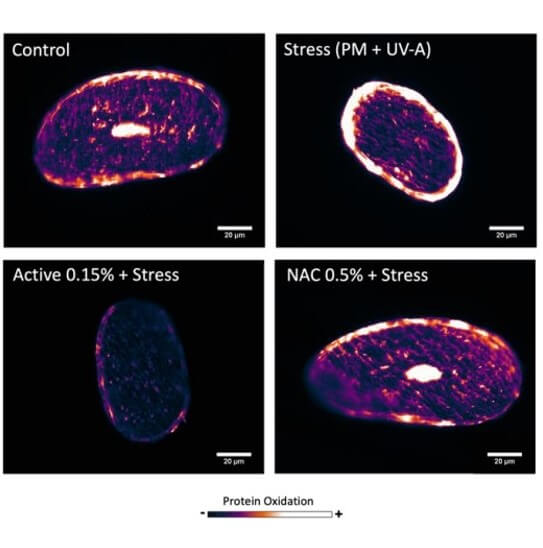Andrea Cavagnino, Arthur Starck, Anaïs Bobier and Martin A. Baraibar *
Background
Environmental factors, such as airborne pollutants and solar UV, induce oxidative damage to proteins and lipids on hair fibers, leading to decreased hair strength and shine, increased fiber porosity, brittleness, dryness, and stiffness.
Traditional methods used for hair damage/protection/reparation assessment show limitations in sensitivity or specificity for evidencing the benefits to be gained from the protection/reparation of hair fibers against environmental stressors.
(2) Methods: Ex vivo experimental models of hair fibers exposed to urban pollutants and UV irradiation were developed. Targeted proteomics approaches for the quantification of oxidatively damaged (carbonylated) proteins on hair fibers were optimized.
(3) Results: A significant dose-dependent increase in carbonylation both in the cuticle and cortex proteins was observed upon exposure of hair fibers to particulate matter and UV-A radiation, at daily stress equivalent doses. Increased protein carbonylation on keratins and keratin-associated proteins led to loss of hair fiber structural integrity. The oxidative modification of proteins induced by urban pollution exposure led to hair cuticle structural damage revealed by an increased permeability. However, protein carbonylation was prevented in the presence of antioxidant compounds. (4) Conclusions: Protein carbonylation is an early event in hair fiber damage which can be used as a reliable biomarker for the efficacy of hair care interventions against environmental stressors.
1. Introduction
Hair fibers are anatomically constituted by three layers: cuticle, cortex, and in certain cases medulla. Flat and square-shaped cuticle cells are adhered tightly to the cortex cells proximally. A healthy cuticle is characterized by a smooth surface, allowing reflection of light and limiting friction between shafts [1]. Smooth cuticles result in glossier and soft hair.
On the other hand, the cortex accounts for most of the hair shaft and is responsible for the great tensile strength of the fiber. It is localized around the medulla and is composed of elongated cortical cells packed tightly together and oriented parallel to the fiber direction. The organization of the cortex cells allows them to be stretched extensively
CONTACT
martin.baraibar@oxiproteomics.fr










 Follow us on Linkedin!
Follow us on Linkedin!
You must be logged in to post a comment.